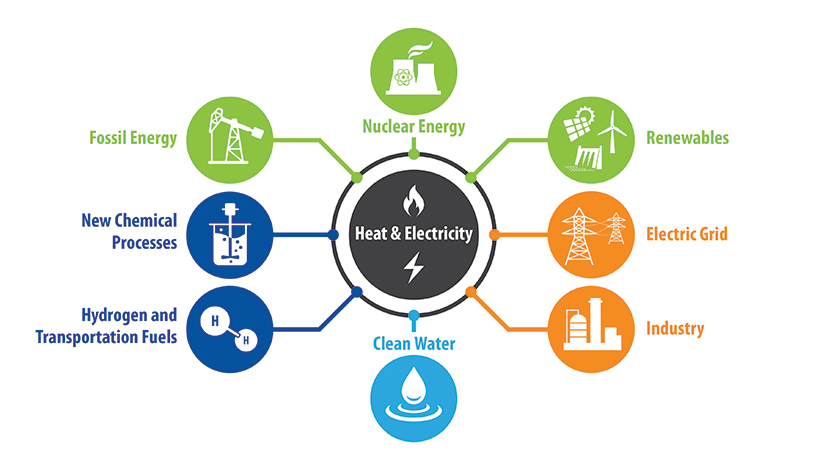Future novel hybrid energy systems could lead to paradigm shifts in clean energy production, according to a paper published last week in Joule.
Researchers from the U.S. Department of Energy’s (DOE’s) three applied energy laboratories—Idaho National Laboratory (INL), the National Renewable Energy Laboratory (NREL), and the National Energy Technology Laboratory (NETL)—co‑authored the paper describing such integrated energy systems.
Their effort outlines novel concepts to simultaneously leverage diverse energy generators—including renewable, nuclear, and fossil with carbon capture—to provide power, heat, mobility, and other energy services. The historic collaboration between the nation’s nuclear energy, renewable energy, and fossil energy laboratories aims to address a grand national challenge from an objective, holistic perspective.
“Working together, researchers at the nation’s applied energy laboratories have identified critical synergies among different power generation sources, which will be vital to transforming our energy economy,” said Martin Keller, director of NREL. “We look forward to advancing these creative solutions, collaboratively.”
The new article presents an objective new framework for engineering-based modeling and analysis to support complex optimization of energy generation, transmission, services, processes and products, and market interactions.
In short, it outlines a viable path forward for hybrid energy systems. Such systems are capable of leveraging multiple energy sources to maximize the value of each. They do this by creating higher-value products, delivering lower-emission energy to industry, and better coordinating demand with energy production.

“The design of integrated energy systems is a significant challenge—and opportunity,” INL Director Mark Peters said. “The collaboration by the three applied national laboratories, and the setup and operation of real-world experiments at their testing facilities, represents a comprehensive and focused effort that is transparent and objective. This work will help realize future advanced energy systems that should help our nation expand affordable energy options and significantly contribute to wide-scale decarbonization efforts.”
The paper describes one example of the multi-input, multi-output nature of these systems: a hypothetical, tightly coupled industrial energy park that uses heat and electricity from highly flexible advanced nuclear reactors, small-scale fossil generators, and renewable energy technologies to produce electricity and hydrogen from electrolysis.
“In this scenario, depending on market pricing, electricity and or heat could be sold into the grid, used on-site, or stored for later distribution and use,” said David C. Miller, NETL’s senior fellow for Strategic Systems Analysis & Engineering and co-author of the article. “Furthermore, the output streams could also be used to produce hydrogen or other valuable chemicals and products.”
This flexibility could provide an abundant supply of clean energy for a larger net-zero-emission energy system. Such systems could support sectors of the economy that are more difficult to decarbonize, such as industry and transportation.
“Considering complementary attributes among various energy technologies opens up new opportunities for asset use optimization that meet multiple energy services and maximize economic value,” said Douglas Arent, NREL’s executive director for Strategic Public-Private Partnerships and the study’s lead author.
Groundwork for the article began in 2018, when NETL, NREL, and INL hosted the first tri-lab workshopPDF in response to DOE Deputy Secretary Mark Menezes’ call for more coordinated work across the DOE applied energy laboratories. Building off knowledge gained during that collaboration, a focused workshop was held in April 2019 on the priority topic Modeling & Analysis of Current & Future Energy Systems. A third tri-lab workshop, held July 31– Aug. 1, 2019, focused on addressing the science and technology challenges associated with the design, development, and deployment of new and advanced materials and components that will enable integrated hybrid energy systems.
“The National Energy Technology Laboratory is proud to partner with INL and NREL in this foundational work,” NETL Director Brian J. Anderson said. “The complimentary expertise across the three labs are bringing revolutionary ideas to the table on how to design and optimize integrated energy systems of the future.”
As illustrated by the NETL-NREL-INL research to date, the design of hybrid energy systems will require input from experts across the spectrum of energy research. To that end, the body of work by the three applied national laboratories, including the tri-lab workshops and the recent Joule article, represent a significant step forward toward realizing the advanced energy systems of the future.
“The national laboratories offer a diversity of expertise that will allow us to achieve effective, cross-sector collaboration that is necessary to solve the true energy and environment grand challenges of our time,” said Shannon Bragg-Sitton, INL lead for Integrated Energy Systems and co-author of the article.
NREL is the U.S. Department of Energy’s primary national laboratory for renewable energy and energy efficiency research and development. NREL is operated for the Energy Department by the Alliance for Sustainable Energy, LLC.


Comments are closed.